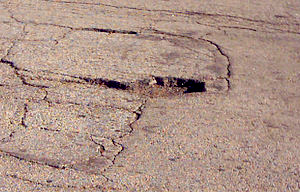
|
CONNECTIONS
|
IDAHO
ITD
HOME
IDAHO DMV
ITD
NEWS
HIGHWAY
SAFETY
IDAHO STATE
POLICE
TRAVEL SERVICES
STATE OF IDAHO
NATIONAL
AASHTO
AAMVA
AAA of IDAHO
FEDERAL HIGHWAYS
FEDERAL AVIATION
IDAHO STATE POLICE
NHTSA
NTSB
TRB
U.S. DOT
Idaho
Transportation
Department
Public Affairs Office
P.O. Box 7129
Boise, ID 83707
208.334.8005
Fax: 208.334.8563
Email

Freeze/thaw cycle prompts highway restrictions
The simple term for a vexing annual occurrence in northern climates is “spring breakup,” a reference to the potential impact on highways of long, cold winters and the recurring cycle of thaws and freezes.
Maintenance crews learn to live with spring breakups of short duration; prolonged cycles, however, bring the risk of significant damage to highway surfaces. The problem can be especially acute on highways that carry a high volume of traffic or heavy commercial vehicles.
 “As
frost escapes from under the roadway, the roadbed begins to crack and
break up,” explains John Perfect, District 1 Maintenance engineer.
“This year we’ve had a lot of freeze/thaw cycles and several
weeks of sub-30-degree temperatures without precipitation.
“As
frost escapes from under the roadway, the roadbed begins to crack and
break up,” explains John Perfect, District 1 Maintenance engineer.
“This year we’ve had a lot of freeze/thaw cycles and several
weeks of sub-30-degree temperatures without precipitation.
“The freeze and thaw cycles that we’ve had in the morning is causing us a lot of problems.”
Moisture and temperature changes cause “wicking,” explains Carl Main, maintenance services engineer in the Office of Highway Operations and Safety.It is more problematic on older highways that tend to have a tighter granular structure that fosters the upward movement of moisture. With no place for release, that moisture freezes, expands and begins straining the surface, causing the highway to heave slightly. When subjected to high speeds and heavy loads, soft spots begin to wear, eventually breaking up and creating potholes.
“The tighter the gradation of subsurface material, the more wicking and frost heaves occur,” Main said. Newer highways tend to be less vulnerable because more porous material is used.
The first remedy is prevention – placing speed and weight limitations on vulnerable highways to help reduce the risk of major deterioration. Both help reduce the “dynamic load” placed on highways and protects the fluctuating sub-grade from cracking and breaking the surface.
Highways can withstand some movement caused by freeze-thaw
cycles, but place vehicles operating at high speeds and trucks bearing
heavy loads and significant damage to occur. Potholes are a manifestation
of the annual cycle. So are cracks and edge breaks.
District 1 hasn’t implemented speed restrictions because of spring
breakup for about five years, Perfect said. And it’s been “years”
since weight limits were placed on highways in the district.
But with the constant freezing and thawing this year, several restrictions have been necessary. All of Idaho 57, part of Idaho 200 and part of U.S. 2 have been posted for 14,000-pound maximum loads per axle; Idaho 3 is approved to carry up to 60,000 pounds per axle. Speed restrictions are in place for part of Idaho 41 and U.S. 2, from Washington to La Clede – a stretch of about 16 miles; 11 of those miles also are posted with a weight restriction.
If the limitations are put in place early enough in the season, the risk of damage is reduced and the life of the highway can be extended, the maintenance engineer said.
Even with those precautions, maintenance crews can look
forward to a busy spring, filling potholes and repairing other highway
damage. The prescription now is to use cold, in-place asphalt patches
because “hot-mix” plants are not operating yet, Perfect
explained.
In stretches hit hardest by spring breakup, crews may need to apply
overlays or rebuild sections of the roadway.
Those fixes are not normally built into the maintenance budget, so District 1 may have to live with stopgap measures until the new fiscal years begins July 1.
The spring breakup isn’t limited to District 1, however. Most of the districts experience some annual damage because of the freeze/that cycle. Speed and weight limitations are not uncommon in districts 5 and 6, both on and off the state highway system.
Motorists are urged to be patient – and especially tolerant of slowed trucks – when traveling on highways where limitations have been placed. Sometimes motorists assume that trucks must pull into slow-vehicle turnouts and allow faster traffic to pass.
That is not the case, according to Idaho State Police trooper Jeff Jayne in a recent interview with the Bonner County Daily Bee (Sandpoint). Truck drivers observing the frost law are not required to yield to faster traffic. State law requires any motorist – including truck drivers – operating below the speed limit to pull off the highway at the first opportunity whenever three or more vehicles line up behind them.
“Technically, they’re not in violation of that because they‘re doing the speed limit for the frost law,” Jayne explained.
Drivers should avoid taking risks, such as passing on curves and hills, when encountering slower truck traffic. The best advice is to be patient and wait for safe passing opportunities so everyone arrives safely at their destination.
Published 3-23-07